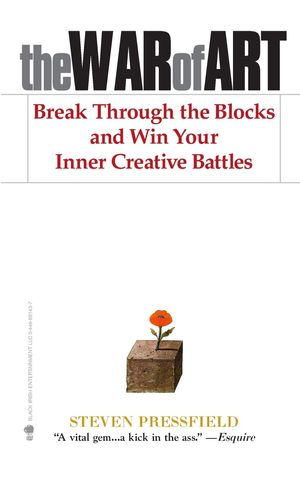
The War of Art: Break Through the Blocks and Win Your Inner Creative Battles
by Steven Pressfield
read in Feb 2021
book info on goodreads
The key theme of Pressfield’s book revolves around the idea of Resistance to creative work, how Resistance can be overcome and how Resistance relates to his idea of a higher level calling. He argues that the creative work itself is not difficult, but that what is difficult about the work is actually getting started to do the work. That force that keeps us from getting started is Resistance. He refers to Resistance as the most toxic force on earth that separates a human’s lived and unlived lives. It is the negative force that pushes us away from the work-in-potential. Interestingly, he writes, Resistance does not have power in and of itself. Resistance is feeding off of us and our fear of it. While the ordinary reader might confuse Pressfield’s notion of Resistance with the common understanding of procrastination, Pressfield argues that Resistance is more general:
“Procrastination is the most common manifestation of Resistance because it’s the easiest to rationalize.”
There are other manifestations of Resistance. For example, anything that draws attention to ourselves is; anything that brings us in trouble is or anything that hurts others is.
To overcome Resistance, Pressfield suggests one clear path; becoming a professional. The professional clearly distinguished himself or herself from the amateur. The professional loves creative work so much he or she dedicates his or her life to it. Pressfield says that, to beat Resistance, the creative must learn how to be miserable:
“The artist committing himself to his calling has volunteered for hell whether he knows it or not. He will be dining for the duration on a diet of isolation, rejection, self-doubt, despair, ridicule, contempt, and humiliation. […] He has to know how to be miserable. He has to love being miserable.”
While I agree with the idea of having to deal with isolation, rejection and humiliation, I disagree that this is necessarily about being miserable. I think while some people, probably non creatives, would see it as a miserable life, the creative probably does not see it as such. The creative is devoted to it and can find excitement in the boring and little things that others would find miserable. Only by accepting that rejection and humiliation is part of the process and at the same time the price for being a creative rather than just watching others from the outside. The professional does not take humiliation personally. Humiliation, perceived as such, Pressfield argues is simply the external reflection of internal Resistance.
In the third part of the book, Pressfield elaborates on the relation between professionals their higher level calling. When talking about muses, magic, god and higher levels of existence, it becomes a bit too esoteric for myself. There is, however, two more interesting ideas that he presents, which again relate to the idea of amateur vs professional. First, he distinguishes the ego from the self. The ego is concerned with the status quo and the things that are external. That means it is controlled by Resistance. The self wishes to grow and to create new things. The second distinction he makes is between hierarchical and territorial orientation. People that are hierarchical oriented compare themselves with and compete against others. This orientation leads to what he calls hacks; people that create what the market is looking for rather than what is in his or her own heart. This orientation can be fatal for creatives. Creatives he argues must be territorially oriented. They must do work for their own sake rather than for the status and hierarchy that comes with it. Pressfield asks:
“What about ourselves as artists? How do we do our work? If we were the last person on earth, would we still show up at the studio, the rehearsal hall, the laboratory?”